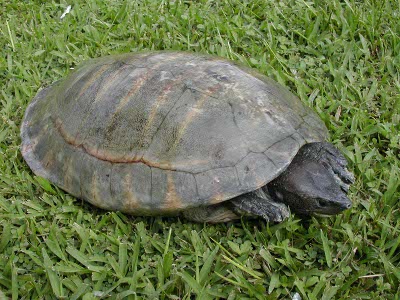Central American River Turtle
Category: Turtle

Facts about Central American river turtles. "Scientific name for Central American river turtle is Dermatemys mawii". The Central American river turtle is commonly known as the hickatee turtle or the white turtle. The species is the only extant turtle which belongs to the family Dermatemydidae. The Central American river turtles closest relatives are derived from fossils with a few nineteen genera which can be illustrated from a worldwide distribution from Cretaceous and Jurassic.
The Central American river turtle can be found in the central Atlantic drainage of the American countries including parts of southern Belize, Guatemala and Mexico. The Central American river turtle is a relatively large species which has previously had various historical records with some of the species developing up to lengths of about twenty four inches(61 cm) with weights of approximately twenty two kilograms(48.5 lbs.). However, a typical Central American river turtle can grow up to weights of about eleven to fourteen kilograms (24 to 30 lbs.).
The Central American river turtle has a smooth, flattened low carapace. However, the juveniles display a median keel with a uniform olive, black, gray or brown coloration. The Central American river turtles plastron is yellow to white in color although it has substrate staining in some parts.
The juvenile Central American river turtle have clear keel which is located at the center of the carapace with serrations on the outer edges. However, as the Central American river turtle matures, some of the features are lost and the body displays a similar coloration to the shell with peach-colored markings or reddish coloring's on the underside and around the neck. It is easier to differentiate the male Central American river turtle from the females due to the yellow colored markings on both sides of their heads and a thicker longer tail.
The Central American river turtle is nocturnal and prefers the aquatic habitats. It rarely leaves the waters to bask in the open sun except when it’s ready to lay eggs. In addition, the Central American river turtle is an herbivorous type of species which feeds entirely on flowers, leaves, figs and other terrestrial vegetation.
The reproductive and breeding season of the Central American Turtle is usually in late rainy seasons during the months of September and December and at the beginning of the dry seasons in the months of January and February. The Central American river turtle is capable of laying a maximum of four clutches with an average of two to twenty eggs per clutch and with weight sizes of less than 33 pounds (15 kg) annually.
The Central American river turtle is classified as a critical endangered species, listed under the United States Endangered Species Act due to the fact that the Central American river turtle is heavily exploited. The Central American river turtle has been hunted and harvested in large for its meat, shells and eggs. The Central American river turtle has been reported to be less popular in its former ranges which include areas in southern Mexico. More over, most of the available species have smaller sizes compared to the naturally occurring species in other regions. The Central American river turtle is rarely kept in captivity due to its value in the food market which has led to its exploitation. Generally, the species nocturnal and passive nature has made it very easy to hunt. This has led to the Central American river turtle being listed as a CITES Appendix II in order to help prevent hunting and exportation of the turtle.

 Back To Category Turtle
Back To Category Turtle